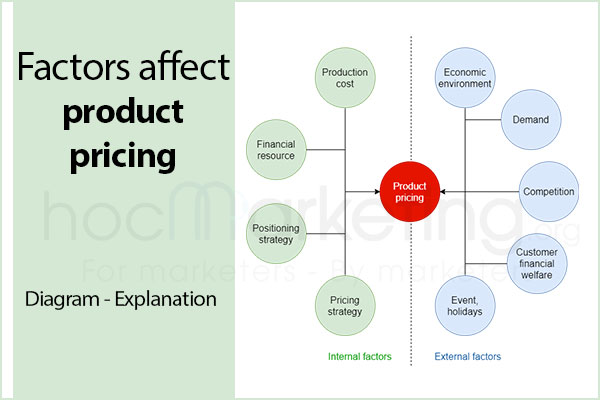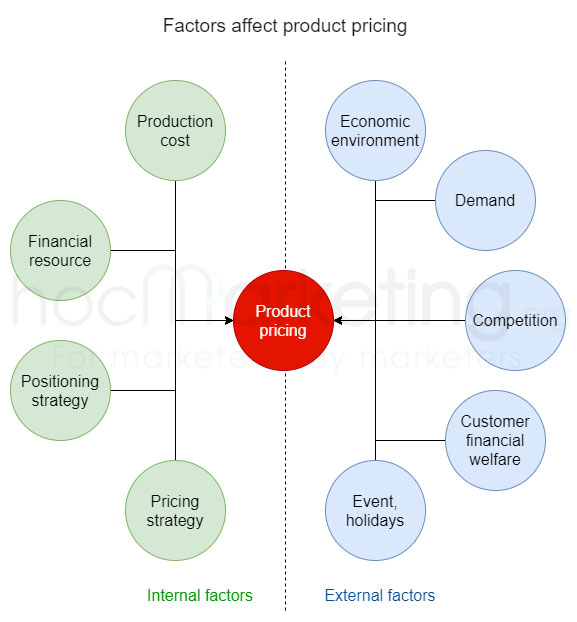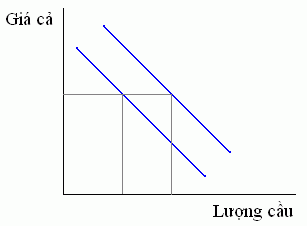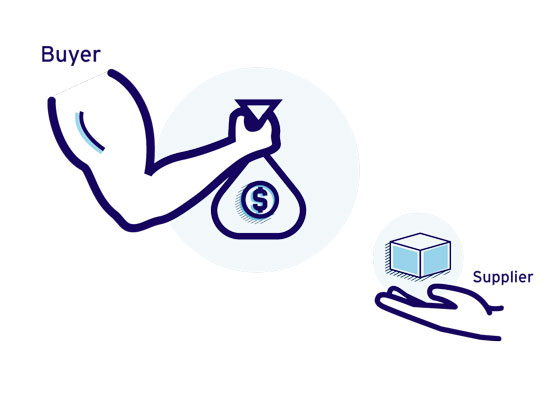
Factors affecting product pricing

Product pricing is an important and complex stage: Important because the price of a product affects many aspects of a business such as revenue, profit; Complicated because product pricing needs to be based on many factors. And this post will detail the factors affecting product pricing.
Product pricing is an important and complex stage. It's important because the price of a product affects many aspects of a business such as revenue, profit, marketing strategy, business strategy, etc... It's complicated because product pricing needs to be based on many factors. Therefore, hocmarketing.org will detail the factors affecting product pricing.
Factors affecting product pricing
In general, there are totally 9 factors affecting product pricing and those factors can be classified into 2 groups: internal factors (Production costs, Financial resources) , Positioning Strategy, Pricing Strategy) and external factors (Economics, Market Demand, Competition, Target customers' finances, Seasons). To have a better view, let's take a look at the chart below.
Internal factors affecting product pricing
1. Production cost
The cost of production is the biggest factor that directly affects the pricing of any one product. By a simple calculation, we can imagine that, in order for a business to be profitable, the price of the product sold must be greater than the total cost of producing that product. Therefore, the higher the production cost per product, the higher the product price will be and vice versa.
2. Financial resources of the enterprise
Some businesses may sell products at a price equal to or less than the cost of production for a certain period of time with the goal of competing and capturing market share. To do that, businesses must have abundant financial resources. However, some businesses with limited financial resources will not be able to apply this method.
The finance of the enterprise is obtained through the following sources: Capital from the founding members of the company, investment capital from shareholders, the difference in the value of shares, profits obtained through business activities. Enterprises with abundant financial resources will have more choices in product pricing.
3. Product positioning strategy
Product positioning strategy is one of the strategic factors of a business that affects pricing. The essence of product positioning is the job of determining the price and quality of a business's product/service relative to its competitors. Therefore, the product positioning strategy has partly determined the product / service price to be located at a certain range on the product positioning map.
4. Pricing Strategy
Pricing strategy is the next strategic factor affecting product pricing in the market. There are many pricing strategies that businesses can adopt, each of which affects the price of a product in different ways. For example, a company applying a skimming price strategy will set a price as high as possible at the time the product has just hit the market. Or when applying the segmentation price strategy, businesses will have to determine many different prices for each different customer for the same product.
External factors affecting product pricing
1. Economy
The economy of a country, or a locality affects many aspects of the material life of individuals living in that society, including the price of products/services in the market. When the economy goes down, the spending ability of customers is also dragged along, making businesses need to make price adjustments to suit the financial capabilities of the target customers.
Although most countries adopt a market economy model, there are still cases where the price of a product/service is controlled and regulated by the government. Most of these cases fall and essential items such as electricity, water, petrol...
2. Demand
In a market economy, demand is a macro factor that affects the price of products/services circulating in the market. When the demand increases compared to the supply, the price of the product will tend to increase. Vice versa, when the demand decreases compared to the supply, the price of the product will also tend to decrease.
In marketing, demand represents the number of customers who have needs that a business's product/service can satisfy and are able to access and pay for the product/service. When the demand tends to increase, the business can price the product at a higher level to earn more profit and vice versa.
3. Competition
Competitors always have a certain influence on the pricing process of a company's products. Most prices for similar products from competitors are always compared in pricing meetings.
If we look closely, we can see price wars of similar products in the market. Sometimes, a change in the price of a product in the market will lead to a change in the price of similar products offered by other businesses.
4. Target customers' financial welfare
Depending on the financial characteristics of the target customers, such as income, occupation, family situation, etc., businesses will determine different prices for their products/services. For products/services aimed at target customers who are people with good economic conditions, businesses usually set a high price, because according to the psychological characteristics of this customer group, the high price proves to be the high quality. In contrast, products aimed at people with tight economic conditions always have low prices to match their spending ability.
5. Seasons & holidays
Businesses usually have different prices for products to suit the demand change during seasons and holidays. For example, in the summer, when people are more relaxed, they will often buy snacks and ice cream. However, at this time of year, many food companies also have special offers to attract customers.
For another example, services such as tourism, convalescence and entertainment always tend to increase in price on holidays because at that time the demand is high.
Conclusion
When it comes to pricing, there are a number of external and internal factors that can affect the cost. Understanding these will help you make educated decisions about how much your product should cost in order to maximize profits while still making sure customers have enough money for what they need. The article has provided examples of each factor so you can see them at work in different industries. We hope this information is helpful!





















